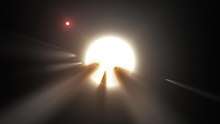2015 XX169
2015 XX169 (also written 2015 XX169) is an Apollo asteroid that is a temporary horseshoe companion to the Earth, the tenth known Earth horseshoe librator.[5] A close encounter with the Earth on 14 December 2015 caused the value of the semi-major axis of 2015 XX169 to drift slowly upwards, and the object evolved from an Aten asteroid to an Apollo asteroid about a year after this close approach.
| Discovery | |
|---|---|
| Discovered by | R. G. Matheny Mount Lemmon Srvy. |
| Discovery site | Mount Lemmon Obs. |
| Discovery date | 9 December 2015 |
| Designations | |
Designation | 2015 XX169 |
| Orbital characteristics[2] | |
| Epoch 16 February 2017 (JD 2457800.5) | |
| Uncertainty parameter 1 | |
| Observation arc | 363 days |
| Aphelion | 1.18545 AU |
| Perihelion | 0.81648 AU |
| 1.00097 AU | |
| Eccentricity | 0.18431 |
| 1.00149 y (365.79 d) | |
| 345.528° | |
| Inclination | 7.640° |
| 256.630° | |
| 283.587° | |
| Earth MOID | 0.0154 AU |
| Physical characteristics | |
| Dimensions | 9–22 m[lower-alpha 1][3][4] |
| 27.4[2] | |
Discovery
2015 XX169 was discovered on 9 December 2015 by R. G. Matheny observing with the 1.5-m reflector telescope at the Mount Lemmon Survey.[6] As of 6 December 2016, it has been observed 47 times with an observation arc of 363 days.[2]
Orbit and orbital evolution
2015 XX169 is currently an Apollo asteroid (Earth-crossing but with a period greater than a year). Its semi-major axis (currently 1.00096 AU) is similar to that of Earth (1.00074 AU), but it has a relatively low eccentricity (0.18431) and moderate orbital inclination (7.640°). It alternates between being an Apollo asteroid and being an Aten asteroid, changing dynamical status approximately every 130 years. As of 9 March 2016, this object is the 15th known Earth co-orbital and the 10th known object following a horseshoe path with respect to our planet. Asteroid 2015 XX169 follows an asymmetrical horseshoe path with respect to our planet; the value of its relative mean longitude oscillates about 180°, but enclosing 0°.[5]
Physical properties
With an absolute magnitude of 27.4, it has a diameter in the range 9–22 meters (for an assumed albedo range of 0.20–0.04, respectively).
Notes
- This is assuming an albedo of 0.20–0.04.
References
- List Of Apollo Minor Planets
- "2015 XX169". JPL Small-Body Database. Jet Propulsion Laboratory. SPK-ID: 3736412. Retrieved 6 December 2016.
- "Conversion of Absolute Magnitude to Diameter". Minor Planet Center. Retrieved 14 April 2020.
- Chesley, Steven R.; Chodas, Paul W.; Milani, Andrea; Valsecchi, Giovanni B.; Yeomans, Donald K. (October 2002). "Quantifying the Risk Posed by Potential Earth Impacts" (PDF). Icarus. 159 (2): 425. doi:10.1006/icar.2002.6910. Archived from the original (PDF) on 4 November 2003. Retrieved 15 April 2020.
- de la Fuente Marcos, Carlos; de la Fuente Marcos, Raúl (1 April 2016). "A trio of horseshoes: past, present and future dynamical evolution of Earth co-orbital asteroids 2015 XX169, 2015 YA and 2015 YQ1". Astrophysics and Space Science. 361 (4): 121 (13 pages). arXiv:1603.02415. Bibcode:2016Ap&SS.361..121D. doi:10.1007/s10509-016-2711-6.
- Discovery MPEC
Further reading
- Understanding the Distribution of Near-Earth Asteroids Bottke, W. F., Jedicke, R., Morbidelli, A., Petit, J.-M., Gladman, B. 2000, Science, Vol. 288, Issue 5474, pp. 2190–2194.
- A Numerical Survey of Transient Co-orbitals of the Terrestrial Planets Christou, A. A. 2000, Icarus, Vol. 144, Issue 1, pp. 1–20.
- Debiased Orbital and Absolute Magnitude Distribution of the Near-Earth Objects Bottke, W. F., Morbidelli, A., Jedicke, R., Petit, J.-M., Levison, H. F., Michel, P., Metcalfe, T. S. 2002, Icarus, Vol. 156, Issue 2, pp. 399–433.
- Transient co-orbital asteroids Brasser, R., Innanen, K. A., Connors, M., Veillet, C., Wiegert, P., Mikkola, S., Chodas, P. W. 2004, Icarus, Vol. 171, Issue 1, pp. 102–109.
- A trio of horseshoes: past, present and future dynamical evolution of Earth co-orbital asteroids 2015 XX169, 2015 YA and 2015 YQ1 de la Fuente Marcos, C., de la Fuente Marcos, R. 2016, Astrophysics and Space Science, Vol. 361, Issue 4, article 121 (13 pp.)


